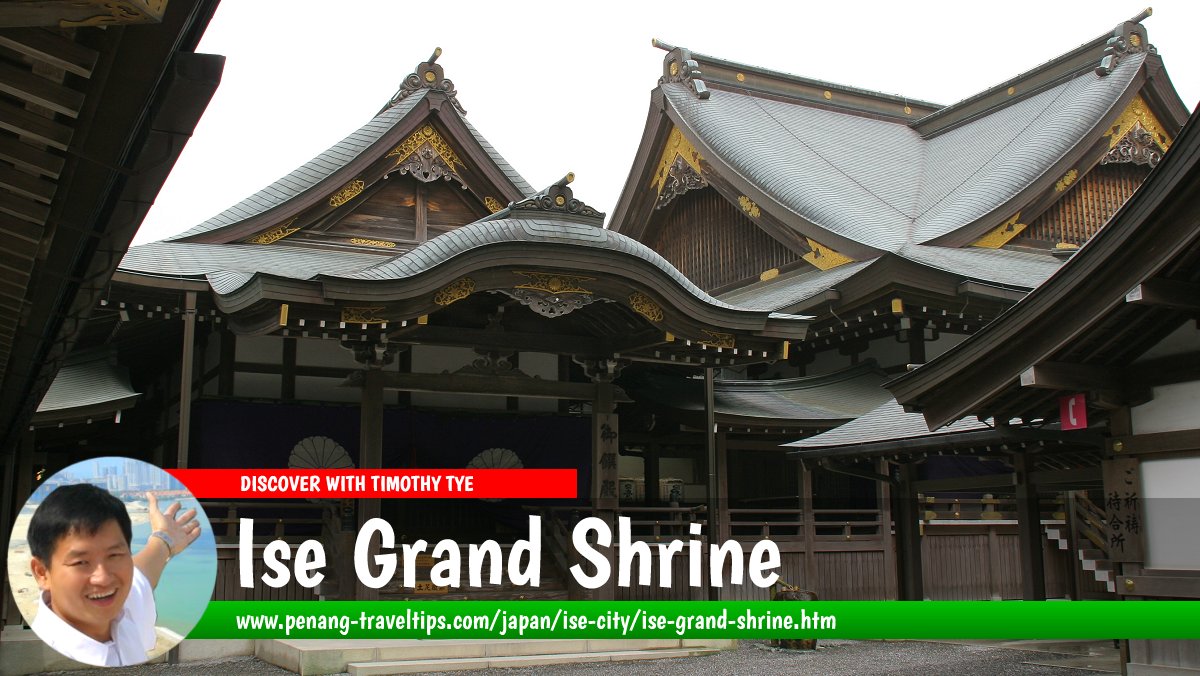 Ise Grand Shrine (2 April 2007)
Ise Grand Shrine (2 April 2007)
Ise Grand Shrine is the most sacred Shinto shrine in Japan. It is located in Ise City, Mie Prefecture. There are actually two shrines, the Inner Shrine or Naiku (officially Kotai Jingu), and the Outer Shrine, or Geku (official name Toyouke Daijingu). However, when tourists refer to the Ise Grand Shrine, they usually mean the Inner Shrine.
The Inner Shrine is dedicated to the Shinto goddess Amaterasu-omikami, the sun goddess and one of the main Shinto deities. The Outer Shrine is dedicated to Shinto goddess Toyouke-omikami, the goddess of agriculture and industry.
The Inner and Outer Shrines are some 6 kilometers apart. They are connected by a pilgrimage road. Being the holiest site in Japan, the Ise Grand Shrine does not allow the common public access into their "holy of holies". Visitors are allowed to walk the grounds, and can only see the top of the thatched roofs of the shrine. Only the high priest or priestess of Ise Shrine is allowed, and the person must come from within the Japanese imperial family.
Between the late 7th century to the 14th century, the high priestess of the Ise Shrine is a female member of the Japanese imperial family holding the title of Saio. Princess Okunohime-miko, daughter of Emperor Temmu, was the first Saio. The Saio system came to an end during the turbulent Nambokucho Period (1336-1392). During the Empire of Japan period (from the Meiji Restoration of 1868 until the defeat in World War II in 1945), the Emperor of Japan played the role of high priest, with emperors Meiji, Taisho and Showa (Hirohito) all having played the role of High Priest of Ise Shrine.
Since the disestablishment of State Shinto under the Occupation of Japan (1945-1952), the high priest and most sacred priestess are former members of the imperial family or their descendents. Presently the High Priest of the shrine is Kitashirakawa Michihisa, the great grandson of the Meiji Emperor. He succeedded his cousin Kuni Kuniaki, the eldest son of Prince Kuni Asaakira and brother of Empress Kojun as high priest in 2001.
The post of most sacred priestess was held by Kitashirakawa Fusako (grandmother of the present high priest) from 1947 until her death in 1974. The post was then assumed by Takatsukasa Kazuko, the third daughter of the Showa Emperor until her retirement in 1988, and was succeeded by her younger sister, Ikeda Atsuko.
Approaching the Inner Shrine
The Ise Grand Shrine is approached through a 100-meter long bridge called the Uji Bridge, which crosses the Isuzu River. From there, visitors and pilgrims pass through a large landscaped garden. After crossing a shorter bridge, they encounter a small, roofed structure called Temizusha. It contains water for ritual purification. Beyond the Temizusha is the first of two torii gates.The first torii gate leads to the Purification Hall, or Saikan, used by the shrine priests to purify themselves before performing ceremonies at the shrine.
After the second torii gate is another hall, the Kaguraden, where the believers offer prayers to the spirits, give donations and purchase talisman for protection, amulets, and scrolls of the Shinto deity. The hall contains the sacred fire used to cook the food offered to the kami at the Ise Shrine.
Beyond that lies the Kotaijingu, the main shrine. A flight of stairs leads up to it. At the top are attendants making sure that photography there is strictly forbidden. Pilgrims are allowed up to the gate to offer their prayers.
Architecture of the Kotajingu
The architecture of the Ise Shrine is unique and may not be used for any other shrines. Moreover, every 20 years the shrine is dismantled and a new one is built adjacent to it, a very costly and minutely specific operation. This allows the shrine to be forever new and forever ancient. The present buildings were erected in 1993. They are the 61st iteration and are scheduled for rebuilding in 2013.The Ise Shrine is built of Japanese cypress. It has a verandah that runs around the outer side. There is also a staircase going up to the single central doorway. The roof is made of thatched reed.
The building stands right next to the site of the previous shrine, called the kodenchi, on which the next shrine will be built. The area is strewn with white pebbles and is empty safe for a small wooden hut, called oi-ya, that houses a wooden pole called the shin-no-mihashira. The wooden pole is always left unseen, for when the new shrine is erected, it is built around the pole, and only then is the oi-ya removed. Meanwhile, a new oi-ya is built to house the shin-no-mihashira of the dismantled old shrine, so that it also remains unseen.
In addition to the Inner and Outer Shrines, the Uji Bridge at the entrance of the Inner Shrine is also rebuilt every 20 years.
 Latest updates on Penang Travel Tips
Latest updates on Penang Travel Tips
 Map of Roads in Penang
Map of Roads in Penang
Looking for information on Penang? Use this Map of Roads in Penang to zoom in on information about Penang, brought to you road by road.
Copyright © 2003-2025 Timothy Tye. All Rights Reserved.

 Go Back
Go Back